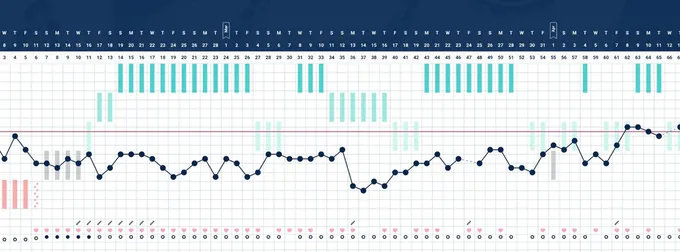What to Expect With Your Cycle Through Perimenopause
Updated July 7, 2025

Throughout a person’s reproductive continuum, it is expected that cycle and hormone changes will occur. For women, perimenopause is the final stage of this continuum and is defined by ‘biological and clinical changes of the cycle in the year prior to and during the first year of menopause.’ Most women experience perimenopause in their 40s, and the onset of menopause occurs close to 50 years of age.
Expected cycle changes
One of the first signs of perimenopause is a delayed period or a longer/shorter cycle compared to aperson’s previously normal cycle length. One large reason for this is hormone balances are changing and fluctuating, and therefore ovulation may be either delayed or occur earlier in the cycle.
For someone tracking their cycles, the early or late ovulation may be detected early in the perimenopausal stage but for others the ‘delayed’ and/or ‘early’ bleed may cause concern and in fact may be mistaken for pregnancy. Worry not! If you are entering this stage, these changes are in fact normal!
So what are some of the most common changes within a perimenopausal cycle?
- Irregular bleeding
- Decreased cervical mucus production
- Shortened luteal phase (post ovulation)
- Anovulatory (no ovulation) cycles
- Longer or shorter overall cycle length
In the beginning, the changes of the cycle may be subtle or infrequent. For example, someone who has a regular 30-day cycle may suddenly experience 27-day cycle or have a heavier period than normal.
As time progresses, there will be more indicators of infertility - which can take years to occur. Someone may experience anovulation one cycle and then over time notice that overall ovulation is occurring infrequently. There may be long delays between the menstrual bleed and the luteal phase (post ovulatory phase) may become shorter over time (another indicator of infertility).
It can be obvious for someone who is tracking their cycles, but for someone who is unaware, it may take longer to realize what's happening.
Eventually cycling will cease all together, and after a year of no menstrual bleeds you are now in the menopausal stage.
How to chart perimenopause
I have many folks who come to me with concerns about charting in the perimenopausal period. With irregular cycles, it can be unpredictable when - or even if - ovulation will occur. Alongside all the other changes, it can feel confusing at times.
Rest assured, charting during this period is possible! It may be easier for someone who has charted for many years already, but it is attainable for anyone who wants to begin tracking their cycles.
I think of this stage like postpartum charting! With postpartum, especially for those who are exclusively breastfeeding, fertility can take weeks or even months to return after birth. You can experience similar symptoms including irregular bleeding, irregular cervical mucus production, and long cycles!
Regardless of the stage you are currently in, we apply the same charting principles. First, it would be especially prudent to seek the help of a certified fertility awareness educator with experience in this area. They can be invaluable and help to confidently guide you in identifying cycle parameters and avoiding a pregnancy (if this is the goal!).
For this stage, I recommend a symptothermal method of cycle charting, a method including both cervical mucus and basal body temperature (the Tempdrop is an excellent asset). With any method of fertility awareness, you are applying the protocols for either avoiding or achieving a pregnancy cycle after cycle. These methods have high efficacy rate when followed correctly and under the supervision of a certified educator.
What temperatures/charting can tell you throughout the process
It is mind-boggling to me the amount of information gained through tracking one’s cycles. And the lack of knowledge surrounding this specialty is saddening. For example, someone tracking their cycles who begins to enter perimenopause will be quite aware of what’s happening from early on.
Let’s say someone is hoping to become pregnant. They are aware of these cycle changes early on and can therefore optimize intercourse timing for conception. Whereas someone who is unaware may go months trying to conceive with irregular cycles and sporadic ovulation, potential missing the opportunity for conception every time.
Working with your cycles and your biomarkers (cervical mucus, basal body temperature, etc) can give you a multitude of information about what's really happening within the body. Short duration of high temperatures in the luteal phase can indicate infertility within the cycle. A decreased amount of cervical mucus production in this period indicates the cervix is beginning to become ‘insensitive’ to the circulating hormones and is therefore trending towards infertility in the menopausal state. All of these are normal and can be easily confirmed through cycle tracking.
In conclusion, I believe charting throughout ANY stage in your reproductive lifetime is of great value - regardless of your fertility goal. You gain valuable information about your hormones, body, and reproductive changes. Perimenopause is no different. And in my opinion, it's a great time to begin cycle tracking to learn more about your own body!




